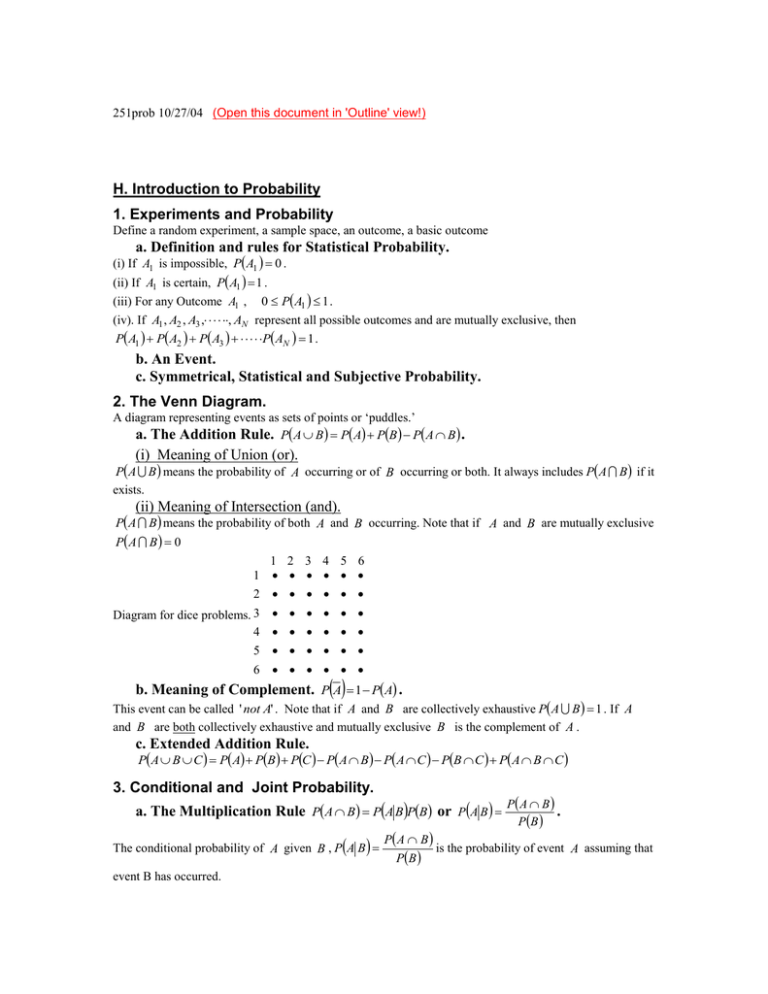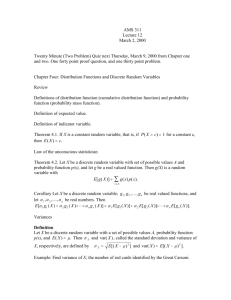Document 15929958
advertisement

251prob 10/27/04 (Open this document in 'Outline' view!) H. Introduction to Probability 1. Experiments and Probability Define a random experiment, a sample space, an outcome, a basic outcome a. Definition and rules for Statistical Probability. (i) If A1 is impossible, P A1 0 . (ii) If A1 is certain, P A1 1 . 0 P A1 1 . (iv). If A1 , A2 , A3 , , AN represent all possible outcomes and are mutually exclusive, then P A1 P A2 P A3 P AN 1 . (iii) For any Outcome A1 , b. An Event. c. Symmetrical, Statistical and Subjective Probability. 2. The Venn Diagram. A diagram representing events as sets of points or ‘puddles.’ a. The Addition Rule. P A B P A PB P A B . (i) Meaning of Union (or). P A B means the probability of A occurring or of B occurring or both. It always includes P A B if it exists. (ii) Meaning of Intersection (and). P A B means the probability of both A and B occurring. Note that if A and B are mutually exclusive P A B 0 1 2 3 4 5 6 1 2 Diagram for dice problems. 3 4 5 6 b. Meaning of Complement. PA 1 PA . This event can be called ' not A' . Note that if A and B are collectively exhaustive P A B 1 . If A and B are both collectively exhaustive and mutually exclusive B is the complement of A . c. Extended Addition Rule. P A B C P A PB PC P A B P A C PB C P A B C 3. Conditional and Joint Probability. a. The Multiplication Rule PA B PA BPB or PA B The conditional probability of A given B , PA B event B has occurred. P A B P B P A B . P B is the probability of event A assuming that b. A Joint Probability Table. What is the difference between joint, marginal and conditional probabilities? Remember that we cannot read a conditional probability directly from a joint probability table but must compute it using the second version of the Multiplication Rule. c. Extended Multiplication Rule. PA B C P C A B P B A PA d. Bayes' Rule. PB A PA B PB P A 4. Statistical Independence. a. Definition: PA B PA b. Consequence: P A B P A PB c. Consequence: If A and B are independent so are A and B , A and B etc. 5. Review. Rule In General Multiplication P A B Addition P A B Bayes' Rule P A B Bayes' Rule P B A PA B PB A and B mutually exclusive 0 P APB P A PB P A B P A PB P A PB P APB PB AP A P B AP A 0 P A 0 PB P B P A B PB A and B independent P A I. Permutations and Combinations. 1. Counting Rule for Outcomes. a. If an experiment has k steps and there are n1 possible outcomes on the first step, n2 possible outcomes on the second step, etc. up to n k possible outcomes on the k th step, then the total number of possible outcomes is the product n1n2 nk . b. Consequence. If there are exactly n outcomes at each step, the total possible outcomes from k steps is nk . 2. Permutations. a. The number of ways that one can arrange n objects: n! b. Prn n! n r ! Order counts! 3. Combinations. a. C rn n! n r !r! Order doesn't count! b. Probability of getting a given combination This is the number of ways of getting the specified combination divided by the total number of possible combinations. If there are a equally likely ways to get what you want and b equally likely possible 2 outcomes, the probability of getting the outcomes you want is a . Example: If there is only one way to get b 48 4 jacks from 4 jacks in a poker hand and C1 ways to get another card, a 1C148 The number of ways to get a poker hand of 5 cards is b C552 , so the probability of getting a poker hand with 4 jacks is 48 a C1 . b C552 3 J. Random Variables. 1. Definitions. Discrete and Continuous Random Variables. Finite and infinite populations. Sampling with replacement. 2. Probability Distribution of a Discrete Random Variable. By this we mean either a table with each possible value of a random variable and the probability of each value (These probabilities better add to one!) or a formula that will give us these results. We can still speak of Relative Frequency and define Cumulative Frequency to a point x 0 as the probability up to that point, i.e. F x 0 P x x 0 3. Expected Value (Expectation) of a Discrete Random Variable. x E x x Px . Rules for linear functions of a random variable: a and b are constants. x is a random variable. a. Eb b b. Eax aEx c. Ex b Ex b d. Eax b aEx b 4. Variance of a Discrete Random Variable. x2 Varx E x 2 E x 2 x2 Rules for linear functions of a random Variable: a. Varb 0 b. Varax a 2Varx c. Varx b Varx d. Varax b a 2Varx Example -- see 251probex1. 5. Summary a. Rules for Means and Variances of Functions of Random Variables. 251probex4 b. Standardized Random Variables, z x . See 251probex2. 6. Continuous Random Variables. a. Normal Distribution (Overview). 4 The General formula is f x 1 2 1 x e 2 2 . Don’t try to memorize or even use this formula. It is much more important to remember what the normal curve looks like. 5 b. The Continuous Uniform Distribution. f x 1 d c f x 0 cxd for otherwise. xc for c x d , F x 0 for x c and F x 1 for x d . d c To find probabilities under this distribution, go to 251probex3. F x c. Cumulative Distributions, Means and Variances for Continuous Distributions. Discrete Distributions Cumulative Function F x 0 Px x 0 Continuous Distributions Px F x 0 P x x 0 x x0 E x Mean Variance xPx E x x2 E x 2 x Px Ex x Px 2 f x dx x 2 f x dx x 2 2 x0 xf x dx x2 E x 2 2 E x2 2 2 2 Example: For the Continuous Uniform Distribution, (i) F x 0 2 x0 c d c d c 2 . f x dx 2 (ii) cd and (iii) 2 12 The proofs below are intended only for those who have had calculus! x0 x0 x c 1 1 1 dx dx x x xc 0 Proof: (i) F x 0 0 c d c c d c d c d c (ii) E x (iii) x2 d c d c x2 x 1 1 1 2 dx x 1 x2 d c d c 2 d 2 c 1 1 1 3 dx 2 x d c d c 3 d 12 dd cc 2 2 cd 13 x 3 c 2 cd 2 2 13 d d cc 14 c 2 2cd d 2 124 c 2 cd d 2 123 c 2 2cd d 2 3 3 c 121 c 2 2cd d 2 d 12 2 6 d. Chebyshef's Inequality Again. P k x k 1 1 k2 and don't forget the Empirical Rule Proof and extensions 7. Skewness and Kurtosis (Short Summary). Skewness: 3 E x 3 . For a discrete distribution, this means distribution x Px, and, for a continuous 3 x 3 f x dx Relative Skewness: 1 3 3 Kurtosis: 4 E x 4 . For the Normal distribution 4 3 4 Coefficient of Excess: 1 4 3 4 4 7
![Problem sheet 1 (a) E[aX + b] = aE[X] + b](http://s2.studylib.net/store/data/012919538_1-498bfd427f243c5abfa36cc64f89d9e7-300x300.png)



